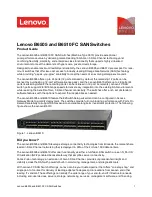
– 206 –
C
HAPTER
8
| Spanning Tree Algorithm
Configuring Loopback Detection
C
ONFIGURING
L
OOPBACK
D
ETECTION
Use the Spanning Tree > Loopback Detection page to configure loopback
detection on an interface. When loopback detection is enabled and a port
or trunk receives it’s own BPDU, the detection agent drops the loopback
BPDU, sends an SNMP trap, and places the interface in discarding mode.
This loopback state can be released manually or automatically. If the
interface is configured for automatic loopback release, then the port will
only be returned to the forwarding state if one of the following conditions is
satisfied:
◆
The interface receives any other BPDU except for it’s own, or;
◆
The interfaces’s link status changes to link down and then link up again,
or;
◆
The interface ceases to receive it’s own BPDUs in a forward delay
interval.
N
OTE
:
If loopback detection is not enabled and an interface receives it's
own BPDU, then the interface will drop the loopback BPDU according to
IEEE Standard 802.1w-2001 9.3.4 (Note 1).
N
OTE
:
Loopback detection will not be active if Spanning Tree is disabled on
the switch.
N
OTE
:
When configured for manual release mode, then a link down/up
event will not release the port from the discarding state.
CLI R
EFERENCES
◆
"Editing VLAN Groups" on page 890
P
ARAMETERS
These parameters are displayed in the web interface:
◆
Interface
– Displays a list of ports or trunks.
◆
Status
– Enables loopback detection on this interface.
(Default: Enabled)
◆
Trap
– Enables SNMP trap notification for loopback events on this
interface. (Default: Disabled)
◆
Release Mode
– Configures the interface for automatic or manual
loopback release. (Default: Auto)
◆
Release
– Allows an interface to be manually released from discard
mode. This is only available if the interface is configured for manual
release mode.
Summary of Contents for LGB6026A
Page 6: ...ABOUT THIS GUIDE 4...
Page 40: ...38 CONTENTS...
Page 60: ...58 SECTION I Getting Started...
Page 86: ...84 SECTION II Web Configuration Unicast Routing on page 517 Multicast Routing on page 575...
Page 162: ...160 CHAPTER 5 Interface Configuration VLAN Trunking...
Page 196: ...194 CHAPTER 6 VLAN Configuration Configuring MAC based VLANs...
Page 204: ...CHAPTER 7 Address Table Settings Clearing the Dynamic Address Table 202...
Page 238: ...CHAPTER 11 Class of Service Layer 2 Queue Settings 236...
Page 254: ...252 CHAPTER 12 Quality of Service Attaching a Policy Map to a Port...
Page 448: ...446 CHAPTER 16 Multicast Filtering Multicast VLAN Registration...
Page 470: ...468 CHAPTER 17 IP Configuration Setting the Switch s IP Address IP Version 6...
Page 576: ...574 CHAPTER 21 Unicast Routing Configuring the Open Shortest Path First Protocol Version 2...
Page 606: ...604 CHAPTER 22 Multicast Routing Configuring PIMv6 for IPv6...
Page 620: ...618 CHAPTER 23 Using the Command Line Interface CLI Command Groups...
Page 672: ...670 CHAPTER 25 System Management Commands Time Range...
Page 692: ...690 CHAPTER 26 SNMP Commands...
Page 700: ...698 CHAPTER 27 Remote Monitoring Commands...
Page 854: ...CHAPTER 34 Port Mirroring Commands Local Port Mirroring Commands 852...
Page 862: ...860 CHAPTER 36 Address Table Commands...
Page 958: ...956 CHAPTER 40 Quality of Service Commands...
Page 1034: ...1032 CHAPTER 42 LLDP Commands...
Page 1044: ...1042 CHAPTER 43 Domain Name Service Commands...
Page 1062: ...1060 CHAPTER 44 DHCP Commands DHCP Server...
Page 1206: ...CHAPTER 47 IP Routing Commands Open Shortest Path First OSPFv3 1204...
Page 1250: ...1248 SECTION IV Appendices...
Page 1256: ...1254 APPENDIX A Software Specifications Management Information Bases...
Page 1278: ...1276 COMMAND LIST...
















































